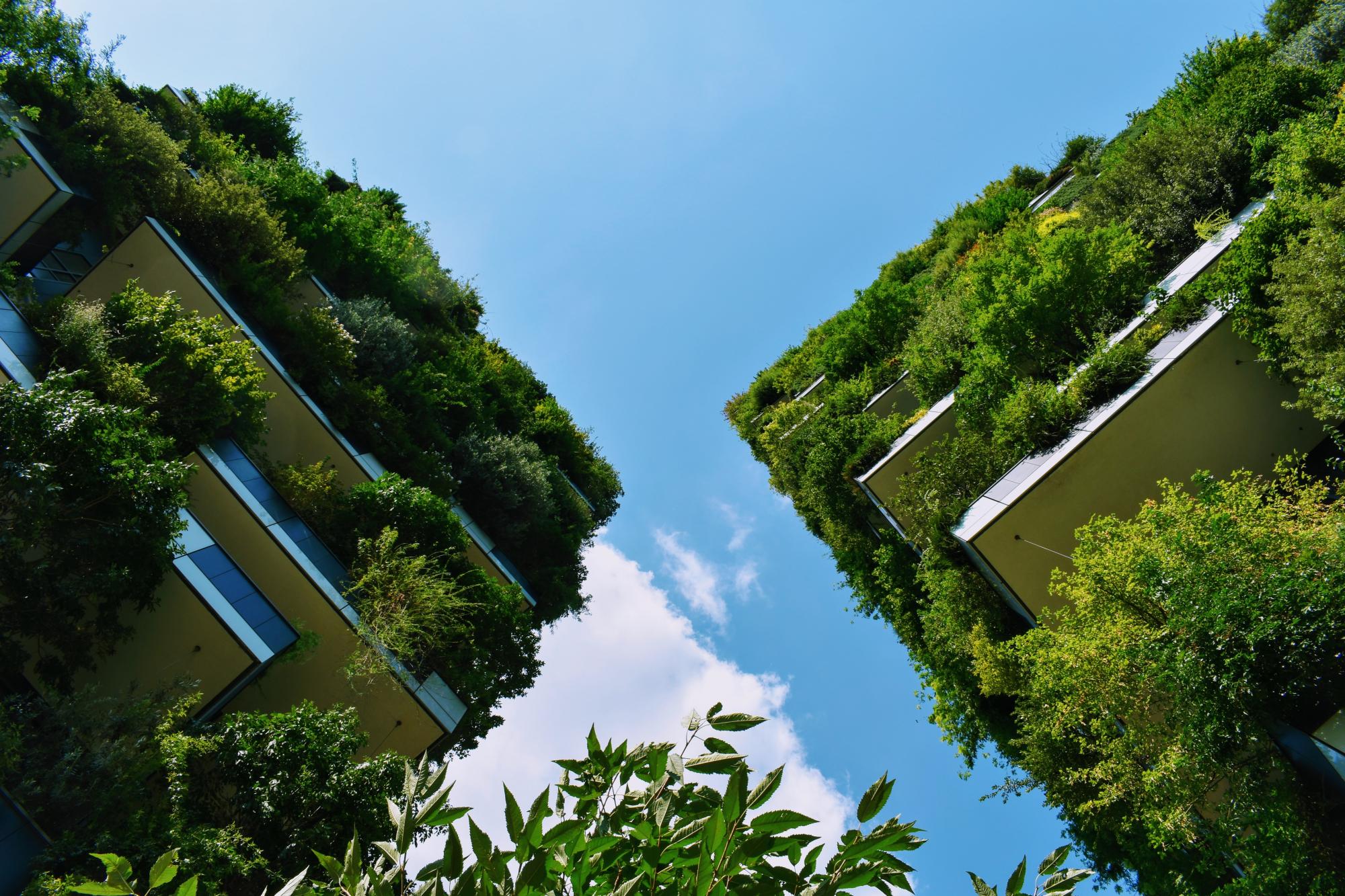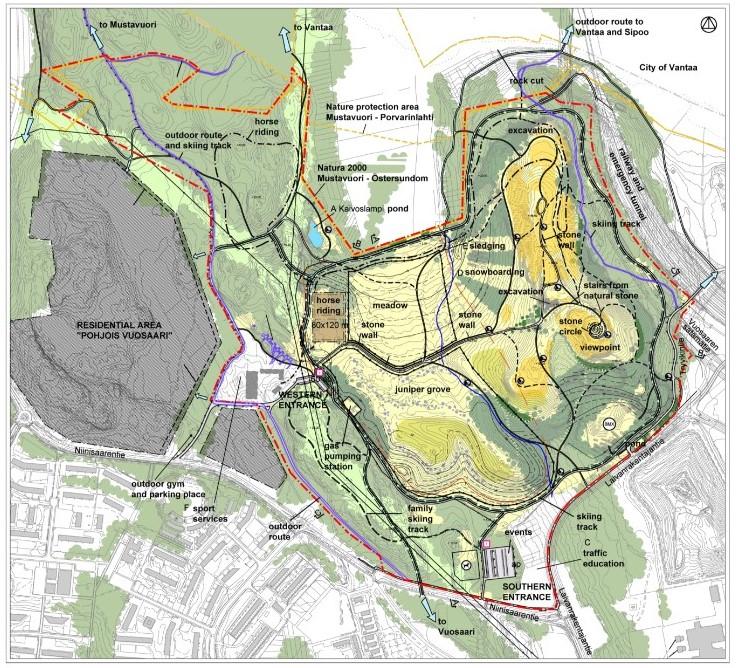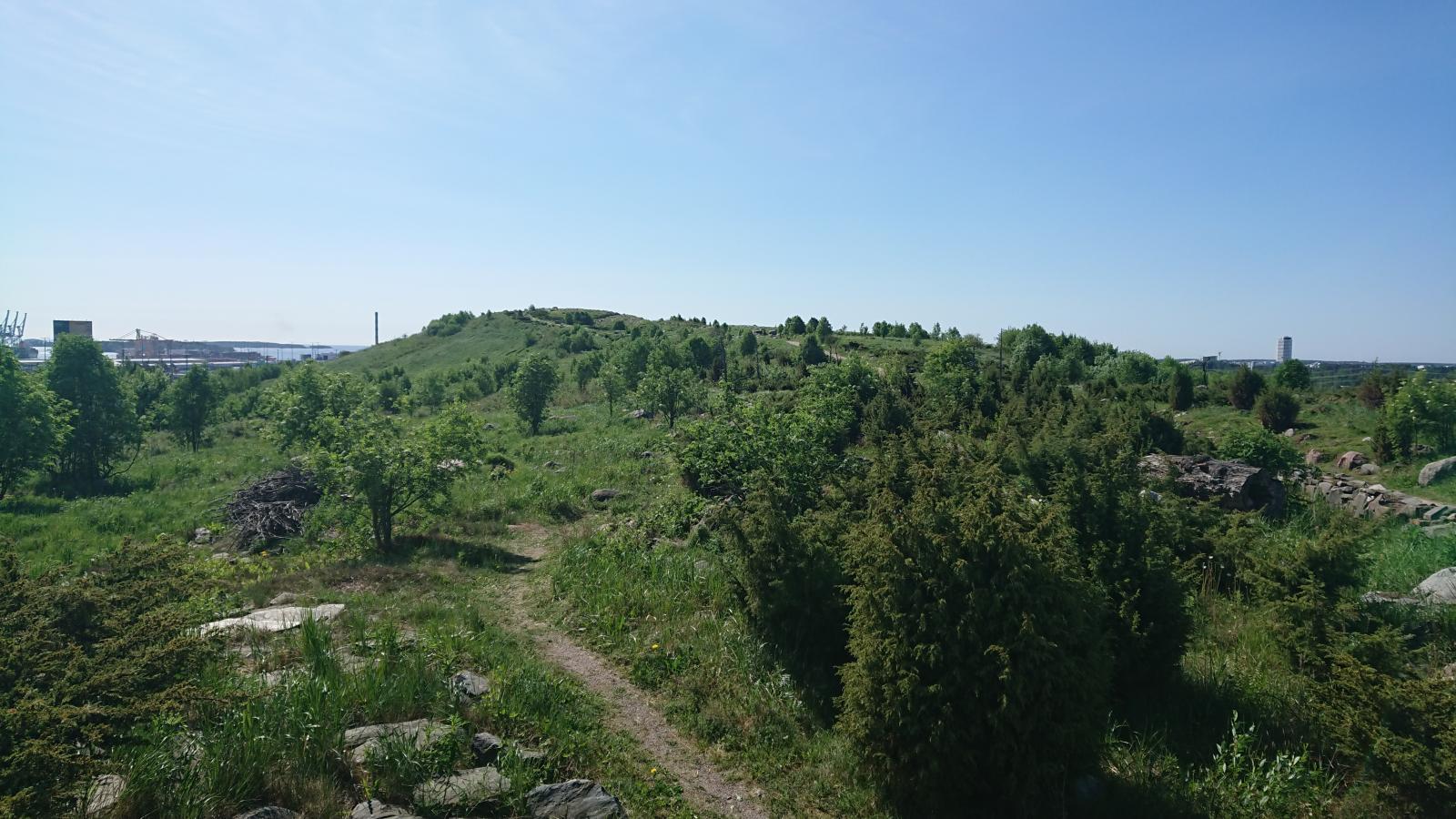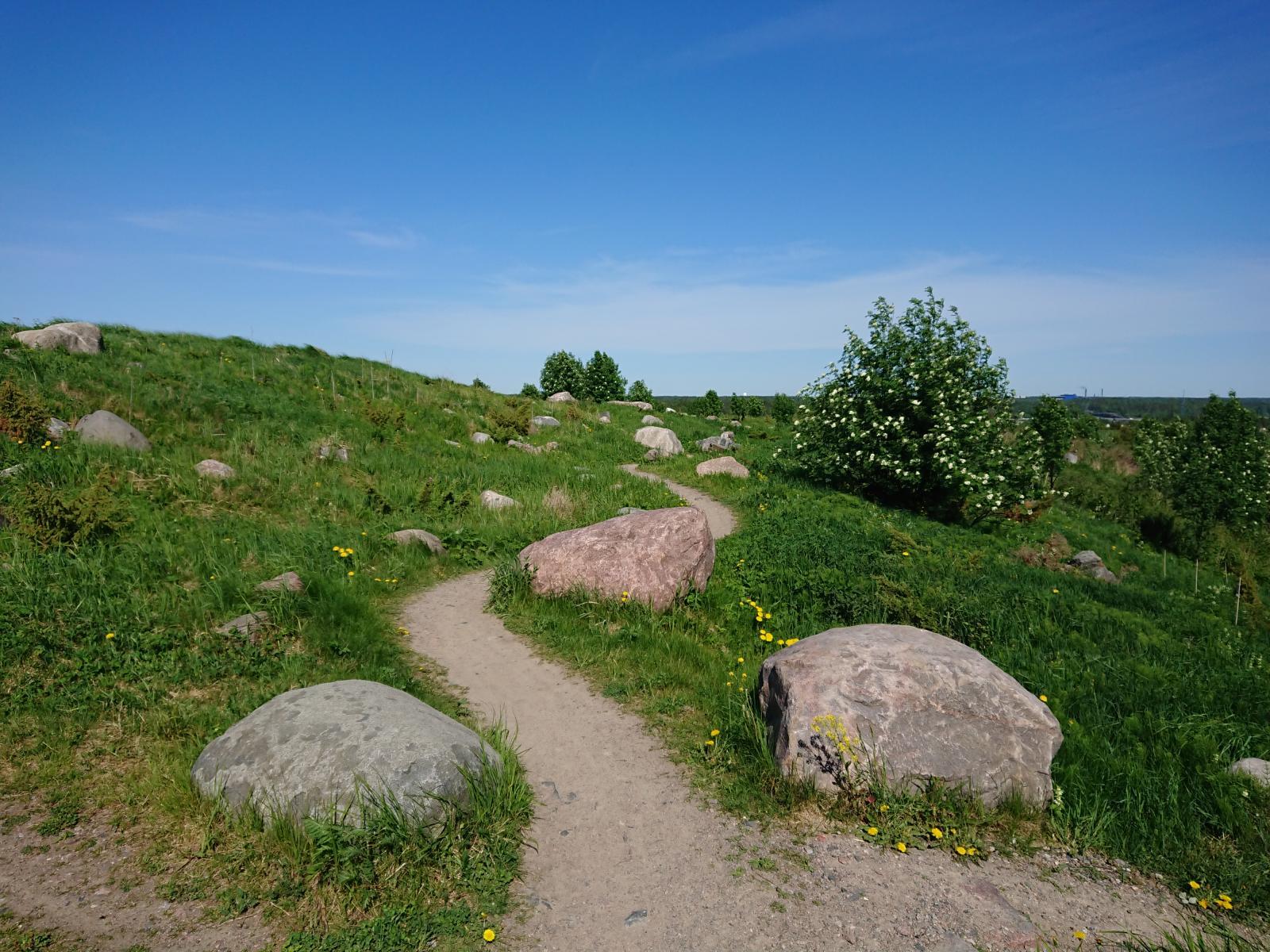Last updated: October 2021
The landscaping of the Vuosaari landfill site has appeared to be an excellent example of ”Integrated Planning Approach” as following concepts were applied: restorative design; ecological design; regenerative development and conventional design (ref. 1). The unused Vuosaari landfill hill had been transformed into a natural area where now domestic plants grow in meadows and rocky conditions. The area is now also used for recreational, educational and scientific purposes (ref 1, 2). The purpose of the project was to promote social, economic and environmental activities at the Vuosaari landfill site (ref. 1).
Overview
Nature-based solution
- Parks and urban forests
- Large urban parks or forests
- Green areas for water management
- Sustainable urban drainage systems
Key challenges
- Water management (SDG 6)
- Improvements to water quality
- Green space, habitats and biodiversity (SDG 15)
- Habitat and biodiversity restoration
- Green space creation and/or management
- Environmental quality
- Soil quality improvement
- Waste management
- Regeneration, land-use and urban development
- Promote natural styles of landscape design for urban development
- Health and well-being (SDG 3)
- Creation of opportunities for recreation
Focus
Creation of new green areas, Ecological restoration of ecosystems, Transformation of previously derelict areas
Project objectives
1. To promote social, economic and environmental activities at the Vuosaari landfill site (ref 1);
2. To imitate the landscapes and habitats that are typical to the North European nature with rich and unique biodiversity (ref 1);
3. Raise awareness and knowledge of the regional biodiversity (ref 1);
4. Compensate for the loss of recreational space due to the construction of the harbour and new housing in northern Vuosaari (ref 1);
5. Create a regional node connecting several outdoor routes with regional importance (ref 1);
To summarize, the landfill site is transformed into a natural area where domestic plants grow in meadows and rocky conditions. The area is used for recreational, educational and scientific purposes (ref. 2).
Implementation activities
The landscaping project occurred simultaneously with the construction of the harbour. 1. Plants that are typical to the area and organisms that promote succession have been transferred from the harbour area to the site, 2. A top layer of 80 000 m3 of soil was spread over 7 hectares to hold the planted seeds, 3. No introduction of deeply rooted vegetation, 4. Create a drainage system of terraces and broken rock (ref 1).
During the landscaping planning process, altogether 227 plant and tree species (Table 1) were selected and recommended for the re-vegetation and restoration of the habitats –114 ruderal and bare land, 45 grassland and meadow, 43 woodland, 12 moist woodland, and 13 other species. The criteria for the selection were –domesticity, significant butterfly community support, beauty, and vitality (ref. 1).
390 vascular plant species, and 9 endangered, 16 near threatened, and38 least concern insect species (for example the Large Copper (Lycaena dispar) and the Wormwood (Cucullia absinthii).
Biodiversity conservation or restoration-focused activities
Biodiversity restoration:
- Rehabilitate and restore damaged or destroyed ecosystems
- Restore species (native, endangered, or unspecified)
- Restore native species
- Public engagement
Main beneficiaries
- Researchers/University
- Citizens or community groups
Governance
Management set-up
- Co-governance with government and non-government actors
Type of initiating organisation
- Local government/municipality
Participatory approaches/ community involvement
- Unknown
Details on the roles of the organisations involved in the project
The project was a joint effort of the Public Works Department of the Helsinki City and the Helsinki Port Authority, but the landscaping plan was completed by FCG Finnish Consulting Group Ltd. (at the time Suunnittelukeskus Ltd.) (ref. 1)
Project implemented in response to ...
... an EU policy or strategy?
Yes
(1. The Directive of 26 April 1999 on the landfill of waste (Ref 1, 3)
2. EU Directive on the Landfill of the Waste (ref. 1)
3. EU Bird Directive (ref. 1))
... a national policy or strategy?
Yes
(The Land Use and Building Act No 132 (came into force 2000) and dictates the regional-, master- and detailed plan of the area (Ref 1)
Helsinki Action Plan for Sustainability 2002 (specifically "Protecting and Fostering Biodiversity in Helsinki) (ref. 1)
The Helsinki's Master Plan 2002 (Ref. 1))
... a local policy or strategy?
Yes
(1. The intervention is based on the goals defined by the Helsinki Action Plan for Sustainability 2002 (specifically "Protecting and Fostering Biodiversity in Helsinki) 2. The Helsinki's Master Plan 2002 offers a long-term perspective (Specifically that "Accessibility to the green city network and recreational areas of the city-region will be guaranteed. The preservation of natural diversity and landscape culture will be a key feature of the Plan" and "emphasis will be put on the quality of public outdoor areas. Green areas will be used in a more effective way"), The Helsinki Regional Plan (Ref 1). )
Financing
Total cost
Unknown
Source(s) of funding
- Unknown
Type of funding
- Unknown
Non-financial contribution
Unknown
Impacts and Monitoring
Environmental impacts
- Environmental quality
- Improved soil quality
- Green space and habitat
- Promotion of naturalistic styles of landscape design for urban development
- Increased green space area
- Increased conservation or restoration of ecosystems
- Increased conversion of degraded land or soil
- Increased number of species present
- Restoration of derelict areas
Economic impacts
- Unknown
Socio-cultural impacts
- Social justice and cohesion
- Improved access to urban green space
- Health and wellbeing
- Gain in activities for recreation and exercise
- Education
- Increased knowledge of locals about local nature
Type of reported impacts
Expected impacts
Presence of formal monitoring system
Yes
Presence of indicators used in reporting
Yes
Presence of monitoring/ evaluation reports
Yes
Availability of a web-based monitoring tool
No evidence in public records
References
1: Tvrdý, J. (2013). Landscaping of Vousaari landfill site in Helsinki, Finland. Available at: Source link (Accessed: 22 July 2020)
2: Vierikko, K. & Fors, H. (2017). Helsinki, Finland: Case Study City Portrait; part of a GREEN SURGE study on urban green infrastructure planning and governance in 20 European cities. Available at: Source link (Accessed: 22 July 2020)
3: European Union. n.d. Waste. European Commission. Available at: Source link (Accessed: 22 July 2020)
4: Hybrid Parks. n.d. Hybrid parks. Available at: Source link (Accessed: 22 July 2020)
5: City of Helsinki the Public Works Department. (2013). Vuosaaren täyttömäki. Available at: Source link (Accessed: 22 July 2020)
2: Vierikko, K. & Fors, H. (2017). Helsinki, Finland: Case Study City Portrait; part of a GREEN SURGE study on urban green infrastructure planning and governance in 20 European cities. Available at: Source link (Accessed: 22 July 2020)
3: European Union. n.d. Waste. European Commission. Available at: Source link (Accessed: 22 July 2020)
4: Hybrid Parks. n.d. Hybrid parks. Available at: Source link (Accessed: 22 July 2020)
5: City of Helsinki the Public Works Department. (2013). Vuosaaren täyttömäki. Available at: Source link (Accessed: 22 July 2020)
Vuosaari Landfill Restoration (2018)
CG Design and Engineering Ltd., retrieved 08/22/2018 from Jan Tvrdy
Vuosaari Landfill Restoration (2018)
CG Design and Engineering Ltd., retrieved 08/22/2018 from Jan Tvrdy




